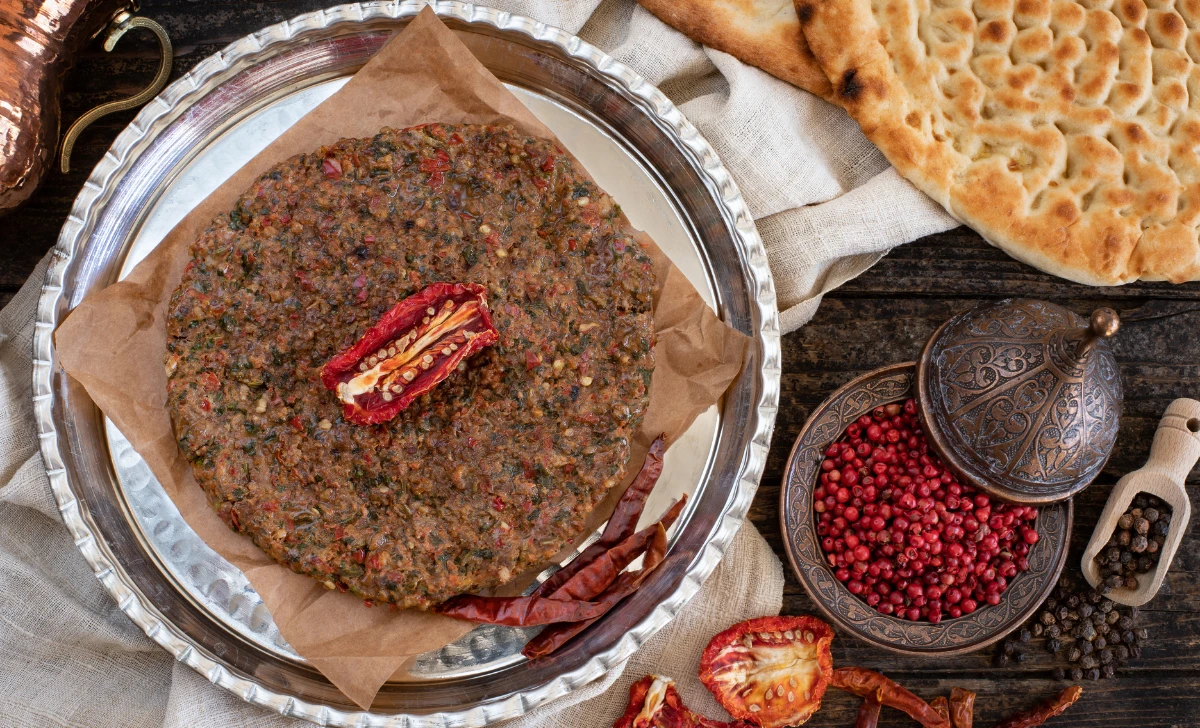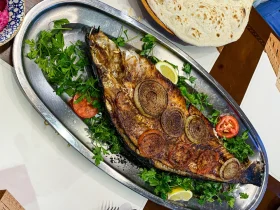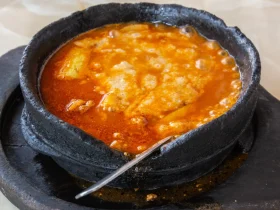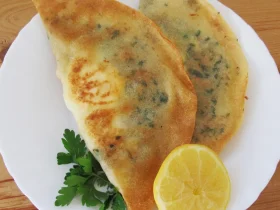If you’re a fan of exotic flavors and a grilling enthusiast, get ready to embark on a culinary journey with the delectable Kagit Kebab. This traditional Turkish delight is a symphony of mouthwatering ingredients, perfectly marinated and cooked to perfection on an open flame. In this article, we’ll explore the art of crafting the sensational Kagit Kebab, step by step, while unraveling the secrets behind its unique flavors and textures.
[ez-toc]
History
The captivating aroma of sizzling meat and the mouthwatering blend of spices in Kagit Kebab evoke a sense of tradition deeply rooted in the history of Turkish cuisine. As we delve into the origins of this delectable dish, we unravel a tale that spans centuries, weaving cultural influences, culinary innovations, and the spirit of communal dining.
Ancient Beginnings: A Glimpse into the Past
The roots of Kagit Kebab trace back to the ancient lands of Anatolia, where early civilizations forged the foundations of Turkish gastronomy. The art of grilling meats over an open flame was an essential part of daily life, providing sustenance and a source of conviviality for communities.
Nomadic Culinary Traditions: The Birth of Kebabs
Nomadic tribes that roamed the Anatolian steppes played a pivotal role in shaping the evolution of Kagit Kebab. These tribespeople, known for their resourcefulness and culinary prowess, discovered that skewering meat and cooking it over an open fire resulted in tender, flavorful morsels. This simple yet ingenious cooking method paved the way for what we now know as kebabs.
Innovative Techniques: The Birth of Kagit Kebab
The transition from traditional skewered kebabs to the unique Kagit Kebab involved a stroke of culinary creativity. The inspiration for cooking meat within parchment paper, akin to modern-day Kagit Kebab, is believed to have emerged from the need for efficient and flavorful food preparation during nomadic journeys. The parchment acted as both a cooking vessel and a flavor enhancer, infusing the meat with the rich aroma of the spices.
Regional Influence: Southeastern Turkey’s Culinary Gem
While kebabs have permeated Turkish cuisine as a whole, Kagit Kebab found its true home in the southeastern region of Turkey. This area, renowned for its diverse cultural influences, provided fertile ground for culinary experimentation. Local cooks refined the technique of cooking meats within parchment paper, resulting in the exquisite dish we know today.
Cultural Significance: Kagit Kebab as a Gathering Tradition
In Turkish culture, food is more than sustenance; it’s a vehicle for forging connections and strengthening bonds. Kagit Kebab became a centerpiece of communal feasting, where friends and family would gather around the grill, eagerly awaiting the unveiling of these parchment-wrapped treasures. The act of unwrapping the parchment paper became a ritual that signaled the beginning of a shared culinary experience.
Global Recognition: Spreading the Delight
As Turkish cuisine gained recognition on the global stage, so did the allure of Kagit Kebab. Travelers and food enthusiasts who ventured to Turkey marveled at the unique preparation and flavors of this dish. With the advent of international food festivals and culinary exchanges, Kagit Kebab transcended geographical boundaries, captivating palates far beyond its place of origin.
Modern Resurgence: Tradition Meets Innovation
In recent years, Kagit Kebab has experienced a resurgence in popularity, both in its traditional form and through innovative interpretations. Modern chefs pay homage to the dish’s historical significance while infusing it with contemporary twists, incorporating diverse ingredients and techniques to cater to evolving tastes.
Preserving a Heritage: Passing Down the Flame
As the culinary world continues to evolve, the essence of Kagit Kebab remains steadfast, preserving the flavors, techniques, and cultural heritage of Turkey. This cherished dish serves as a link between generations, connecting modern food enthusiasts with the nomadic traditions of their ancestors.
Time
| Step | Time Required |
|---|---|
| Preparation: Marinating the Ingredients | 15 minutes (plus marination time) |
| Assembling the Kebabs | 20 minutes |
| Cooking on the Grill | 15-20 minutes |
| Unwrapping and Serving | 5 minutes |
| Total Time | Approximately 55-60 minutes |
Please note that the marination time can vary depending on your preference, but allowing the meat to marinate for at least 2-4 hours will yield the best results in terms of flavor and tenderness. The cooking time on the grill may also vary based on the type of grill you’re using and the thickness of the meat and vegetables.
Ingredients
| Ingredients | Quantity |
|---|---|
| Boneless lamb or chicken | 300 grams |
| Bell peppers (assorted colors) | 1 large or 2 small |
| Tomatoes | 2 medium |
| Red onion | 1 small |
| Greek yogurt | 1/4 cup |
| Olive oil | 2 tablespoons |
| Garlic cloves | 2-3 cloves |
| Paprika | 1 teaspoon |
| Ground cumin | 1/2 teaspoon |
| Ground black pepper | 1/4 teaspoon |
| Salt | To taste |
| Parchment paper | 2 sheets |
| Skewers | 4-6 |
| Fresh parsley or cilantro | For garnish |
| Lemon wedges | For serving |
| Fluffy rice or pita bread | For serving |
Feel free to adjust the quantities based on your personal preferences and appetite. Enjoy your cooking and dining experience with this delectable Kagit Kebab recipe!
Directions
Step 1: Marinating the Ingredients
- Prepare the Marinade: In a bowl, combine Greek yogurt, olive oil, minced garlic, paprika, ground cumin, ground black pepper, and a pinch of salt. Mix well to create a flavorful marinade.
- Cut and Marinate: Cut the boneless lamb or chicken into bite-sized pieces. Place the meat in the marinade, ensuring each piece is well-coated. Cover the bowl and refrigerate for at least 2-4 hours, allowing the flavors to infuse and the meat to tenderize.
Step 2: Assembling the Kebabs
- Prep the Vegetables: Wash and cut the bell peppers, tomatoes, and red onion into chunks that are similar in size to the meat.
- Skewer the Delights: Take the marinated meat pieces and thread them onto skewers, alternating with the colorful bell peppers, juicy tomatoes, and slices of red onion. Get creative with your arrangement to achieve a visually appealing kebab ensemble.
Step 3: Cooking on the Grill
- Prepare the Grill: Preheat your grill to medium-high heat. If you’re using charcoal, ensure the coals are evenly lit and glowing.
- Grill with Care: Place the skewers on the grill, ensuring they’re not crowded. Cook for about 8-10 minutes, turning occasionally, until the meat is cooked through and has those irresistible grill marks.
Step 4: Unwrapping and Serving
- Create the Parchment Pockets: Cut two sheets of parchment paper, each large enough to hold a skewer’s worth of ingredients. Place the grilled kebabs on the parchment paper.
- Wrap and Seal: Carefully fold the parchment paper over the kebabs, creating a pocket. Seal the edges by folding and crimping, ensuring the pocket is well-sealed to trap the flavors.
- Unveil the Delights: Gently open the parchment pockets just before serving, releasing the mouthwatering aroma of the Kagit Kebab.
- Garnish and Serve: Transfer the unwrapped kebabs to serving plates. Garnish with freshly chopped parsley or cilantro. Serve with lemon wedges and your choice of fluffy rice or warm pita bread.
Enjoy Your Culinary Masterpiece!
Congratulations, you’ve successfully crafted a plate of exquisite Kagit Kebab that’s sure to impress. The harmonious blend of marinated meat and grilled vegetables, enveloped in parchment paper, captures the essence of Turkish cuisine. Share this delectable delight with your loved ones and relish the flavors that transport you to the heart of Turkey’s culinary heritage.
Equipment Required
Nutrition Information
| Nutrient | Per Serving |
|---|---|
| Serving Size | 1 skewer with veggies |
| Calories | 250-300 calories |
| Total Fat | 12-15 grams |
| – Saturated Fat | 2-4 grams |
| Cholesterol | 60-80 milligrams |
| Sodium | 200-300 milligrams |
| Total Carbohydrates | 10-12 grams |
| – Dietary Fiber | 2-3 grams |
| – Sugars | 3-4 grams |
| Protein | 25-30 grams |
| Vitamin A | 15-20% of DV |
| Vitamin C | 40-50% of DV |
| Calcium | 6-8% of DV |
| Iron | 10-15% of DV |
Please note that these values are approximate and can vary based on factors such as portion size, marination, and specific ingredients used. Always refer to specific product labels or consult a nutritionist for more accurate and personalized nutritional information. Enjoy your Kagit Kebab while being mindful of your dietary needs!
Tips
- Choose Quality Meat: Opt for lean cuts of boneless lamb or chicken to achieve tender and flavorful kebabs.
- Uniform Cutting: Cut your meat and vegetables into similar-sized pieces to ensure even cooking and balanced flavors.
- Master the Marinade: Let the meat marinate for at least 2-4 hours, or even overnight, to maximize flavor infusion and tenderness.
- Soak Wooden Skewers: If using wooden skewers, soak them in water for about 30 minutes before threading to prevent burning on the grill.
- Medium-High Heat: Grill the kebabs over medium-high heat for that perfect char and succulent texture. Keep a close watch to prevent overcooking.
- Seal with Precision: When folding the parchment paper around the kebabs, ensure a tight seal to trap the flavors and moisture.
- Garnish and Citrus: Freshly chopped herbs, like parsley or cilantro, add a burst of color and freshness. Serve with lemon wedges to add a zesty kick.
Pros & Cons
| Pros | Cons |
|---|---|
| ✅ Bursting with Flavor | ❌ Marination Time Required |
| ✅ Nutrient-Rich | ❌ Grilling Skill Needed |
| ✅ Customizable | ❌ Cooking Time Variability |
| ✅ Communal Dining | ❌ Requires Grilling Equipment |
| ✅ Cultural Connection | ❌ Parchment Wrapping Technique |
Conclusion
As we bring our culinary exploration of Kagit Kebab to a close, we invite you to embark on a journey that marries tradition, innovation, and the art of grilling. This Turkish masterpiece encapsulates the essence of communal dining, cultural heritage, and the joy of savoring each bite with loved ones.
From the tantalizing aroma of marinated meat to the visual delight of colorful veggies wrapped in parchment paper, Kagit Kebab promises an experience that transcends mere sustenance. It’s a celebration of flavors, a homage to centuries-old culinary traditions, and a testament to the creativity that can flourish in the kitchen.
Whether you’re a seasoned grilling aficionado or a curious kitchen explorer, Kagit Kebab beckons you to take up the skewer and indulge in its savory charm. The sizzle of the grill, the aromatic spices, and the delightful unwrapping of parchment pockets all contribute to an adventure that teases and pleases the senses.
So, gather your ingredients, fire up the grill, and let the flavors of Turkey’s rich heritage grace your taste buds. With each succulent bite, you’re not just preparing a meal – you’re crafting memories, forging connections, and immersing yourself in the timeless tapestry of food and culture.
Give in to the allure of Kagit Kebab and relish the magic that unfolds with every carefully prepared skewer. Your taste buds deserve this delightful journey, and your culinary repertoire will undoubtedly be enriched by this tantalizing Turkish delight. Don’t resist the temptation – let Kagit Kebab grace your table and elevate your dining experience to new heights. Bon appétit!
Facts
- Fact 1: An Ancient Flame Dance 🔥🕺
- Did you know that the concept of grilling meat on skewers dates back to ancient civilizations? Nomadic tribes roaming the Anatolian steppes discovered the joy of skewering meat and cooking it over open flames, a technique that eventually led to the creation of Kagit Kebab.
- Fact 2: Parchment Paper Magic 📜✨
- The ingenious use of parchment paper in Kagit Kebab isn’t just about cooking; it’s a culinary alchemy! Wrapping the kebabs in parchment paper infuses them with a symphony of flavors and keeps them juicy, resulting in a delightful surprise waiting to be unwrapped.
- Fact 3: A Turkish Skewer Symphony 🇹🇷🍢
- Kagit Kebab isn’t just a dish; it’s a cultural connection that brings families and friends together. In Turkey, the sizzle of kebabs on the grill is akin to a symphony, marking the beginning of a joyous communal feast that celebrates both heritage and friendship.
- Fact 4: From Steppes to Global Plates 🌍🍴
- What started as a nomadic cooking technique has now traveled the world on plates of food enthusiasts. Kagit Kebab’s popularity transcends borders, captivating taste buds in different corners of the globe and showcasing the power of culinary exploration.
- Fact 5: Picasso of the Grill 🎨🍢
- Assembling Kagit Kebab isn’t just cooking; it’s an artistry that lets you wield skewers like a paintbrush and the grill like a canvas. Crafting a colorful masterpiece of marinated meat and vibrant veggies isn’t just a culinary delight—it’s a visual feast that tantalizes all the senses.
FAQ’s
Can I use a different type of meat for Kagit Kebab?
Absolutely! While lamb and chicken are traditional, you can experiment with beef, pork, or even seafood to create your unique twist on Kagit Kebab.
Is there a vegetarian version of Kagit Kebab?
Yes, indeed! Swap the meat with marinated tofu or a mix of grilled vegetables like zucchini, bell peppers, and mushrooms for a delicious vegetarian alternative.
Can I cook Kagit Kebab in an oven instead of on a grill?
While the grill imparts a smoky flavor, you can definitely bake Kagit Kebab in the oven at 375°F (190°C) for about 20-25 minutes, ensuring even cooking and tenderness.
How do I prevent the kebabs from sticking to the grill?
To prevent sticking, make sure your grill grates are clean and well-oiled. You can also brush the kebabs lightly with oil before placing them on the grill.
Can I prepare Kagit Kebab ahead of time?
Absolutely! You can marinate the meat and assemble the kebabs a day in advance, keeping them refrigerated until you’re ready to grill.
What side dishes pair well with Kagit Kebab?
Kagit Kebab pairs beautifully with fluffy rice, warm pita bread, or a fresh salad. Tzatziki sauce or a tangy yogurt dip also make excellent accompaniments.
Can I use metal skewers instead of wooden ones?
Yes, metal skewers can be used. Just be cautious, as they conduct heat and can become quite hot. If using metal skewers, remember to handle them with oven mitts or a towel.
Can I freeze marinated Kagit Kebab for later use?
While marinating, it’s best not to freeze the ingredients, as the texture and flavor may be affected. However, you can freeze cooked Kagit Kebab for future enjoyment.
Are there any alternative wrapping methods for Kagit Kebab?
Yes, you can experiment with aluminum foil or even banana leaves for wrapping, each imparting a unique flavor and aroma to the kebabs.
Can I add extra vegetables to the skewers?
Absolutely! Feel free to get creative and add your favorite veggies like mushrooms, zucchini, or even small potatoes to the skewers for extra variety and flavor.












Leave a Review